This article needs additional citations for verification. (September 2023) |
Incheon International Airport (IATA: ICN, ICAO: RKSI) is the main international airport serving Seoul, the capital of South Korea. It is also one of the largest and busiest airports in the world.
Incheon International Airport 인천국제공항 | |||||||||||||||||||||||
|---|---|---|---|---|---|---|---|---|---|---|---|---|---|---|---|---|---|---|---|---|---|---|---|
 View of ICN in 2023 | |||||||||||||||||||||||
| Summary | |||||||||||||||||||||||
| Airport type | Public | ||||||||||||||||||||||
| Owner | Ministry of Land, Infrastructure and Transport | ||||||||||||||||||||||
| Operator | Incheon International Airport Corporation | ||||||||||||||||||||||
| Serves | Seoul Capital Area | ||||||||||||||||||||||
| Location | Jung District, Incheon, South Korea | ||||||||||||||||||||||
| Opened | 29 March 2001[1] | ||||||||||||||||||||||
| Hub for | |||||||||||||||||||||||
| Elevation AMSL | 7 m / 23 ft | ||||||||||||||||||||||
| Coordinates | 37°27′48″N 126°26′24″E / 37.46333°N 126.44000°E | ||||||||||||||||||||||
| Website | www | ||||||||||||||||||||||
| Maps | |||||||||||||||||||||||
 Closeup of airport on map | |||||||||||||||||||||||
Location in Incheon, South Korea | |||||||||||||||||||||||
| Runways | |||||||||||||||||||||||
| |||||||||||||||||||||||
| Helipads | |||||||||||||||||||||||
| |||||||||||||||||||||||
| Statistics (2023) | |||||||||||||||||||||||
| |||||||||||||||||||||||
| Incheon International Airport | |
| Hangul | 인천국제공항 |
|---|---|
| Hanja | 仁川國際空港 |
| Revised Romanization | Incheon Gukje Gonghang |
| McCune–Reischauer | Inch'ŏn Kukche Konghang |
This airport opened for business on 29 March 2001 to replace the older Gimpo International Airport, which now serves mostly domestic destinations and shuttle flights to several East Asian metropolitan areas, including Beijing–Capital, Osaka–Kansai, Shanghai–Hongqiao, Taipei–Songshan and Tokyo–Haneda.
Incheon International Airport is located west of Incheon's city center, on an artificially created piece of land between Yeongjong and Yongyu Islands. A shallow sea originally separated the two islands. That area between the two islands was reclaimed for the construction project, effectively connecting the once-separate Yeongjong and Yongyu islands. The reclaimed area and the two islands are all part of Jung-gu, an administrative district of Incheon. The airport has 111 boarding gates altogether, with 44 in Terminal 1, 30 in Concourse A (connected to Terminal 1), and 37 in Terminal 2.[citation needed]
This airport was constructed to share the demand for air transport in the 21st century and to serve as a hub airport in Northeast Asia.[4]
History edit

International air traffic to South Korea increased after the 1988 Summer Olympics. In the 1990s, it became apparent that Gimpo International Airport could not cope with the increase in air traffic. The government decided to build a new international airport to reduce the load on Gimpo International Airport.
The new airport was originally planned to be located in Cheongju, 124 km (77 mi) southeast of Seoul, but due to its distance, it was opposed by Seoul and Gyeonggi citizens. [citation needed] Hwaseong was the other choice, but it was also rejected due to similar reasons. Finally, the area chosen was Incheon. [when?]
In November 1992, the construction of the Incheon airport began on reclaimed land between Yeongjong Island and Youngyu Island and took eight years to finish, with an additional six months for testing. Completion was initially scheduled for 1997 but delayed due to the economic crisis.[5] The airport was officially opened on 21 March 2001.[citation needed]
On 15 November 2006, the Airbus A380 landed at the airport as part of the first leg of its certification trip.[6] Tests on the runways, taxiways, and ramps showed that the airport could handle the aircraft.
To further upgrade service, Incheon and major Korean logistics firm Hanjin Group (parent company of Korean Air) agreed on 10 January 2008 to build Yeongjong Medical Centre, which was completed in 2012. This hospital serves nearby residents and some of the 30,000 medical tourists who come to Korea annually.[7]
Statistics edit
Located 48 km (30 mi) west of Seoul, the capital and the largest city of South Korea, Incheon International Airport is the main hub for Korean Air, Asiana Airlines, Jeju Air, and Polar Air Cargo. The airport serves as a hub for international civilian air transportation and cargo traffic in East Asia. In 2016, the Incheon International Airport was the fifth-busiest airport in the world and third in Asia by cargo traffic, and 19th in the world and eighth in Asia by passenger traffic. In 2016, the airport served a total of 57,849,814 passengers.
The airport opened for business in early 2001 to replace the older Gimpo International Airport, which now serves mostly domestic destinations plus shuttle flights to Beijing–Capital, Osaka–Kansai, Shanghai–Hongqiao, Taipei–Songshan and Tokyo–Haneda although flights to Beijing and Osaka also operate from Incheon Airport.
Construction phases edit
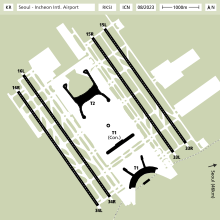
The airport was originally planned to be built in three phases, incrementally increasing airport capacity as the demand grew. This was changed, however, to four phases after the airport was opened.
Phase 1 edit
In Phase 1, the airport had a capacity of 30 million passengers annually, and a cargo capacity of 1,700,000 tonnes (1,673,151 long tons; 1,873,929 short tons) annually.[citation needed] In this phase, a passenger terminal with a floor space of 496,000 square metres (5,338,900 sq ft), two parallel runways, a control tower, an administrative building, a transportation Centre (the Integrated Transportation Centre, designed by Terry Farrell and Partners and Samoo Architects & Engineers), an integrated operations Centre, three cargo terminals, international business Centre, and a government office building were constructed.[citation needed]
Phase 2 edit
Phase 2 construction began in 2002, and was originally expected to be completed in December 2008. However, in an attempt to have the airport ready for the 2008 Beijing Olympics, which took place in August 2008, the schedule was modified, and Phase 2 construction was completed on 20 June 2008. During this construction phase, a third parallel 4,000-metre-long (13,123 ft 4 in) runway and a 13-hectare (32.1-acre) cargo terminal area was added. A 16.5-hectare (40.8-acre) concourse connected to the main passenger building via two parallel 870-metre-long (2,854 ft 4 in) underground passageways were added, with a Mitsubishi Crystal Mover shuttle train APM shuttling passengers between the concourse and the main terminal.[8]
Many long-distance foreign carriers were moved to the new concourse, with Korean Air and Asiana Airlines continuing to use the existing terminal.[citation needed]
Phase 3 edit
The South Korean government invested ₩4 trillion until 2017 to expand Incheon International Airport. The second passenger terminal was constructed in the northern field of the airport, and its existing cargo terminal and other infrastructures were expanded. The terminals are connected by the underground "Starline" train. Also, a Landside Connecting system (Bus shuttle) is used for airport employees and departing passengers who don't come to the right terminal. After completion, Incheon International Airport can handle 62 million passengers and 5,800,000 tonnes (5,708,398 long tons; 6,393,406 short tons) of cargo a year, up from the previous capacity of 44 million passengers and 4,500,000 tonnes (4,428,929 long tons; 4,960,401 short tons). Construction began in 2011 and was completed in 2017. The terminal opened on 18 January 2018. Incheon's expansion also includes adding more aprons to park planes and extending a railway line to the city center of Seoul about 70 kilometres (43 mi) away from the airport. The airport also signed an agreement to build a resort called "Inspire" which includes 6-star hotels, theme parks, and a casino.[9]
Phase 4 edit
Between 2017 and 2024, a fourth construction phase at the airport is taking place. There will be an expansion of Terminal 2, the building of a fourth runway and additional apron and car parking facilities.[10] Following completion of the works, it is expected that the hourly flight capacity of the airport will increase from 90 to 107.[11]
There are long-term plans for a fifth runway and a third terminal.[12]
Terminals edit
Terminal 1 edit
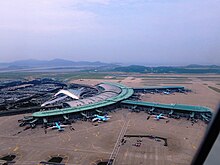
Terminal 1 (measuring 496,000 square metres (5,338,900 sq ft)) is the largest airport terminal by area in South Korea. Terminal 1 was designed by Curtis W. Fentress, FAIA, RIBA of Fentress Architects. It is 1,060 metres (3,480 ft) long, 149 metres (489 ft) wide, and 33 metres (108 ft) high. Its construction cost was 5.632 trillion South Korean Won.[13] The terminal has 44 boarding ports (all of which can accommodate the Airbus A380), 50 customs inspection ports, 2 biological quarantine counters, 6 stationary and 14 portable passenger quarantine counters, 120 arrival passport inspection counters, 8 arrival security ports, 28 departure security ports, 252 check-in counters, and 120 departure passport inspection counters. In 2015, an automatic check-in counter lane was introduced, which people travelling via Korean Air, Asiana Airlines and China Southern Airlines can use. Instead of having airport staff at the counter, there is a machine where travellers input their flight information, scan their passports, receive their flight tickets and lastly, load the luggage onto the conveyor. This system was planned to be introduced in Terminal 2, but in May 2015 Incheon Airport used one of the counter islands for the unmanned luggage handling system.[14]
In December 2023, a Oneworld-branded and operated lounges opened in Incheon Airport Terminal 1 to serve passengers flying on seven of the alliance's 13 member carriers who serve the airport: American Airlines, Cathay Pacific, Finnair, Malaysia Airlines, Qantas, Qatar Airways, and SriLankan Airlines.[15] It is the first in a series of planned lounges under development by the alliance.[16]
Midfield Concourse edit
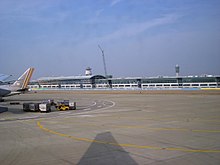
The passenger concourse was completed at the end of May 2008. It is connected to Terminal 1 by two parallel 870-metre-long (2,850 ft) underground passageways equipped with IATs (Intra Airport Transit). It has 30 gates and six lounges.[17]
Terminal 2 edit
A new passenger terminal, designed by Gensler, opened on 18 January 2018, and Korean Air, KLM, Delta Air Lines, and Air France flights were relocated from Terminal 1 to Terminal 2. Other SkyTeam members such as Aeromexico, China Airlines, Garuda Indonesia, XiamenAir, Czech Airlines and Aeroflot started serving the Terminal 2 on 28 October 2018. From 1 July 2023, Jin Air, the low-cost subsidiary of Korean Air, will operate at Terminal 2.[18] And the rest of the SkyTeam members, such as Vietnam Airlines, China Eastern Airlines, Shanghai Airlines and Saudia, will be relocated to Terminal 2 after the Phase 4 construction work is completed.[19]
Airlines and destinations edit
Passenger edit
^1 Aeromexico's flight from Mexico City to Seoul–Incheon operates via Monterrey but the flight from Seoul–Incheon to Mexico City is non-stop.
^2 Korean Air's service between Busan and Incheon is available only to connecting passengers flying with the airline internationally.[163]
^3 Korean Air's service between Daegu and Incheon is available only to connecting passengers flying with the airline internationally.[164]
Cargo edit
Accidents and incidents edit
On 16 June 2011, an Airbus A321-200, operating as Asiana Airlines flight 324 between Chengdu Shuangliu International Airport, China and Incheon International Airport, was fired upon by two soldiers of the Republic of Korea Marine Corps as it came in to land at Incheon. A total of 99 rounds were discharged at the aircraft, which was out of range and made a safe landing without sustaining any damage. The soldiers had misidentified the aircraft as belonging to the North Korean military and were acting on orders that permitted them to engage without reference to senior officers, following the Bombardment of Yeonpyeong in November 2010.[178]
Ground transport edit

Public transport edit
Bus edit
Airport shuttle buses transport passengers between Terminal 1 and Terminal 2. Buses are free, arrive every 5 to 8 minutes, take approximately 20 minutes of travel time, and stop at the Hyatt Hotel or airport fire station en route, depending on direction.
Airport buses are called limousine buses. Standard limousine buses travel to Gimpo Airport & Songjeong station.
Intercity buses connect with other towns and cities in Korea.
The City Air Logistics & Transportation company runs a airport bus line directly connected to the bus station at COEX, Gangnam.[179]

Rail edit
The Airport Railroad Express (AREX and styled as A'REX) has two stations located in both the Transport Centre adjacent to the Terminal 1 building (Incheon International Airport Terminal 1 station) and is in the basement of Terminal 2 (Incheon International Airport Terminal 2 station). It provides service to Gimpo International Airport and Seoul. Many of the stations along the line provide connections to Incheon Subway, Seoul Metropolitan Subway, and Incheon Airport Maglev.
For departing passengers, Seoul Station City Airport Terminal offers in-town early check-in service and has related immigration services before arriving at the airport. After CALT closed its in-town check-in operation at Gangnam in 2023, the Seoul Station City Airport Terminal is the only available place in Seoul where in-town check-in service is provided.[180]
The Korea Train eXpress (KTX) operated at the same station as AREX but used a different platform. It operated 20 times per day from the airport; twelve times on the Gyeonbu Line, twice on the Gyeonjeon Line, four times on the Honam Line, and twice on the Jeolla Line. The service started in 2014 but was suspended in March 2018 due to low ridership.[181] The suspension became permanent in September 2018 as the line was officially closed.[182][183]
The Incheon Airport Maglev opened on 3 February 2016 and closed on 1 September 2023.[184] The first phase was to be 6.1 km long, spread over six stations (but eight stations were built, spanning more than 8 km), taking riders from the airport toward the southwest of the island where a water park is located. Phase 2 was to be 9.7 km long, extending the line to the northwest of the island. Phase 3 would have added 37.4 km, transforming the line into a circle.[185][186][187] After converting the tracks from Maglev to orbital tram tracks,[188] service is expected to resume from March 2024.[189]
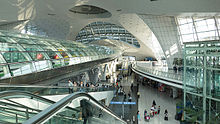
Ferry edit
A ferry service connects Yeongjong-do to the mainland. However, the dock is located a considerable distance from the airport. An alternative means of transport must be sought upon arriving at the island to be able to get to the airport.[190]
Car edit
The airport provides a short-term parking lot for 4,000 cars and a long-term parking lot for 6,000 cars. Shuttle services connect the long-term parking lot to the passenger terminal and the cargo terminal. Car rental is located near the long-term parking lot. A link to the mainland is provided by the toll Yeongjong Bridge and an expressway. A second expressway on the Incheon Bridge also connects the island to central Incheon.
Traffic and statistics edit
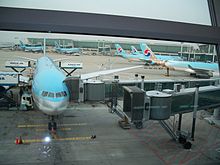

In 2017, the airport was the world's fourth busiest airport by cargo traffic and third in Asia,[191] and the world's 19th busiest airport by passenger traffic and ninth in Asia.[192] In 2019, the airport served a total of 70,857,908 passengers.
Top destinations edit
Annual traffic edit
Graphs are unavailable due to technical issues. There is more info on Phabricator and on MediaWiki.org. |
| Years | Aircraft Operations | Passengers | Cargo (tonnes) | |
|---|---|---|---|---|
| 2001 | 86,807 | 14,542,290 | 1,186,015 | |
| 2002 | 126,094 | 20,924,171 | 1,705,928 | |
| 2003 | 130,185 | 19,789,874 | 1,843,055 | |
| 2004 | 149,776 | 24,084,072 | 2,133,444 | |
| 2005 | 160,843 | 26,051,466 | 2,150,139 | |
| 2006 | 182,007 | 28,191,116 | 2,336,571 | |
| 2007 | 211,404 | 31,227,897 | 2,555,580 | |
| 2008 | 211,102 | 29,973,522 | 2,423,717 | |
| 2009 | 198,918 | 28,549,770 | 2,313,002 | |
| 2010 | 214,835 | 33,478,925 | 2,684,499 | |
| 2011 | 229,580 | 35,062,366 | 2,539,222 | |
| 2012 | 254,037 | 38,970,864 | 2,456,724 | |
| 2013 | 271,224 | 41,482,828 | 2,464,385 | |
| 2014 | 290,043 | 45,512,099 | 2,557,681 | |
| 2015 | 305,446 | 49,281,220 | 2,595,677 | |
| 2016 | 339,673 | 57,765,397 | 2,714,341 | |
| 2017 | 360,295 | 62,082,032 | 2,921,691 | |
| 2018 | 387,497 | 68,259,763 | 2,952,123 | |
| 2019 | 404,104 | 71,169,722 | 2,764,369 | |
| 2020 | 149,982 | 12,094,851 | 2,822,370 | |
| 2021 | 131,027 | 3,198,909 | 3,329,292 | |
| 2022 | 171,253 | 17,869,759 | 2,945,855 | |
| 2023 | 337,299 | 56,131,064 | 3,600,288 | |
| Source: IIAC Airport Statistics[3] | ||||
Awards edit
As of 2021, the airport has been rated by Skytrax as the fourth-best airport in the world. Skytrax has also rated the airport as the world's best international transit airport and one of the world's cleanest airports. The airport is one of Skytrax's 5-star airports and has also been awarded for the best airport security in 2021.[193][194][195][196]
During the entire run of the best airport worldwide ranking by Airports Council International (ACI) from 2005 to 2011, Incheon International Airport topped the ranking every year. ACI also rated the airport as the best airport in Asia-Pacific for 10 consecutive years from 2006 to 2016 until the ranking series ended in 2017.[197]
Its duty-free shopping mall has been rated the world's best for three years in a row in 2013 by Business Traveller.[198]
Facilities edit
This airport has a golf course, spa,[199] private sleeping rooms, an ice skating rink, a casino, indoor gardens, video game center and the Museum of Korean Culture.[citation needed]
In popular culture edit
The Sims 4 Team released The Sims 4: Incheon Arrivals Kit inspired by the fashion at the Incheon airport.[200]
See also edit
Notes edit
References edit
External links edit



